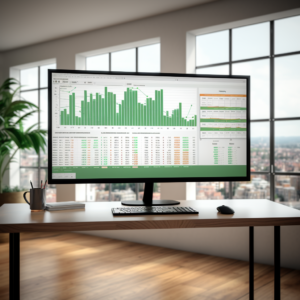Excel Visual Basic for Applications (VBA) is a robust programming language that enables you to automate operations in Excel and create more complex functionalities. Trained professionals often use it to automate repetitive tasks and create custom formulas or functions, enhancing their productivity. This article offers a comprehensive introduction to Excel VBA, starting from the basics to advanced features. Whether you are a beginner or an experienced user, it will provide you with insights and guidelines on how to leverage Excel VBA to improve your efficiency.
Understanding the Basics of Excel VBA
VBA, short for Visual Basic for Applications, is a programming language developed by Microsoft. It is integrated into all Microsoft Office applications, including Excel, and allows users to automate tasks within these applications. In Excel, VBA enables users to automate routine tasks, customize Excel models, build user-defined functions, and much more. If you find yourself repeatedly performing the same operations in Excel, VBA can be a powerful tool to reduce your workload.
The Excel VBA environment is known as the VBA editor. It contains the Project Explorer, which displays a tree view of every open Excel workbook. Each workbook is further divided into worksheets, modules, and other components. The Code Window is another part of the VBA editor where you will write or paste your VBA code.
VBA is an event-driven language, meaning that code can be executed in response to specific events. These events might be user actions such as clicks or keypresses, or system events like opening a workbook. By linking code to these events, users can automate processes to save time and reduce errors.
To understand Excel VBA, you need to understand its syntax, or the rules that govern how scripts are written. Basic concepts include variables and data types, operators, control structures like loops and conditionals, and syntax rules for calling functions and procedures.
Excel VBA: Getting Started with Macros
A VBA Macro is a sequence of instructions that automate complex tasks in Excel. Users can create a macro by recording a series of tasks or by writing VBA code in the VBA editor. To start recording a Macro, one can navigate to the “Developer” tab and click on the “Record Macro” button. As you perform tasks, Excel will record the actions and generate corresponding VBA code.
After recording a Macro, it can be run by navigating to the “Macros” dialogue box and selecting the desired Macro. The Macro can also be linked to a button or a keyboard shortcut for easy access. Once you become comfortable with the recording feature, you can manually edit the VBA code to customize the Macro further.
A key feature of Macros is their capacity to automate repeatable tasks, saving both time and effort. For instance, if you need to format multiple cells in a specific way, you could create a Macro to do this quickly and efficiently. Macros also offer a great way of understanding the VBA language, as you can review the code generated by the Macro recorder.
It is important to be cautious when using Macros, especially when sourced from outside your own work. Macros can contain harmful code, and it is crucial to ensure that your Macro sources are trustworthy. Remember to save your work before running a Macro as some actions may not be easily reversible.
Working with Excel Objects in VBA
In VBA, Excel objects are the primary constructs that you manipulate to automate tasks. Objects represent elements in Excel such as worksheets, ranges, charts, and the application itself. Each object belongs to a specific class, which defines its properties and methods. Properties describe the object’s attributes, while methods are tasks that the object can perform.
The Excel Application object is the top level of the Excel object hierarchy. It represents the entire application and contains all other objects. Worksheet and Range objects are among the most frequently used in Excel VBA. The Worksheet object represents a sheet in a workbook, and the Range object represents a cell, row, column, or a selection of cells containing one or more contiguous blocks of cells.
Objects are manipulated using their properties and methods. For example, you can set the value of a Range object’s Value property to change the contents of a cell, or use the Select method to select a range. To use an object in VBA, you typically declare a variable as a particular object type and then set that variable equal to the object you want to manipulate.
VBA also allows for the creation of collection objects, which are groups of related objects. For example, you can use the Worksheets collection to work with all the worksheets in a workbook simultaneously. Collections are powerful because they allow you to perform operations on multiple objects at once.
Exploring Advanced Features of Excel VBA
After understanding the basics of Excel VBA, you can begin to explore more advanced features. One such feature is Error Handling, which allows you to anticipate and manage potential errors that may arise when your code is run. This is achieved by using the On Error statement, which can be set to perform a specified action when an error is encountered.
User-Defined Functions (UDFs) are another advanced feature. These are custom functions that you can create in VBA and then use in your Excel worksheets just like any built-in Excel function. UDFs are particularly useful when the existing Excel functions are not sufficient for your needs.
Excel VBA also allows you to build custom forms or dialog boxes using UserForms. UserForms are custom user interface screens that you can design and program in VBA. They allow you to create a personalized interaction experience for users of your VBA application.
Finally, you can use VBA to interact with other applications beyond Excel, such as Access, Outlook, or even non-Microsoft applications. This is achieved through Application Programming Interfaces (APIs), which allow different software applications to communicate with each other.
Excel VBA is a powerful tool that can significantly enhance your productivity in Excel by automating repetitive tasks, creating custom functions, and interacting with other applications. By understanding its basics, getting started with Macros, working with Excel objects, and exploring its advanced features, you can leverage Excel VBA to improve your efficiency and accuracy. While learning VBA might seem daunting initially, consistent practice and learning can make you proficient in it, and you’ll soon realize its potential to transform your Excel experience.
Here’s more blogs you might like about Office Productivity on E-learn.guide.











